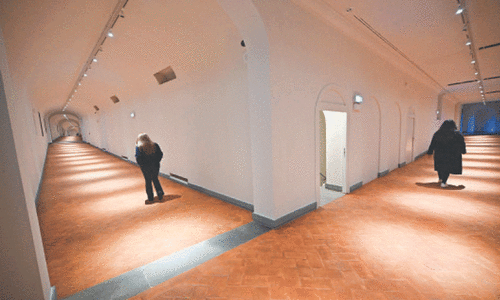GAZA: When the first Palestinian uprising began 14 years ago, Imad Falouji was a young Muslim activist who did not hesitate to urge Palestinians onto the streets to try to drive out occupying Israeli troops.
Now, after almost 15 months of a second uprising, the battle lines have become blurred. This time, the Palestinians have a self-rule authority in which Falouji himself is a minister.
“Now I must speak about agreements, about a ceasefire, about the chance for negotiations to continue. This is complicated, it is not easy now,” the 40-year-old telecoms minister said.
Although Palestinian President Yasser Arafat called this month for armed action against Israelis to cease, he pointedly did not declare an end to the non-violent struggle for independence.
Whether or not Palestinian fighters heed Arafat’s call to halt suicide bombings and armed attacks, the struggle for an independent state is set to continue as long as Palestinians remain under Israeli occupation.
Many Palestinians feel the occupation has been masked to the world by the fact that they now have a self-rule authority — which controls only limited areas of the West Bank and Gaza.
Palestinian analysts say agreements with Israel, beginning with the 1993 Oslo interim accords which heralded an end to the first intifada, may be undermining their international support in the latest struggle.
“The basic point is that now the occupation is hidden under treaties between Israelis and Palestinians under what is called a peace process and having an authority on the ground,” said political science professor Ali Jirbawi.
“Now, even if it is a popular intifada, no one (abroad) is going to accept it because there is an authority on the ground,” he said.
For Israelis, the existence of a self-rule government has changed the equation decisively.
They say the Palestinian Authority has been given control of its people, but has failed to meet its side of the bargain by not doing enough to rein in the Palestinian groups who have taken the violence into Israel through suicide bombers.
“One obvious difference (with the first intifada) is that this time they control the people, despite what they say,” said Israeli political analyst Barry Rubin.
“The second difference is that they are, like in the last one, trying to get the mass mobilization of the people, which they are not very good at, but this time it’s a war,” he said.
Whether or not the conflict meets the international definition of war, both sides agree the bloodshed and violence in the current uprising is on a far greater scale than before.
In the last intifada, the violence was usually an ugly mix of stone-throwing Palestinian youths and Israeli troops using teargas and light arms, often focused around Israeli posts in the centre of towns and cities all over the West Bank and Gaza.
Now the Israeli troops have handed over some of their positions to Palestinian police but the clashes are fiercer.
Palestinians increasingly fight with assault rifles, mortars and suicide bombers. Israel’s response has included bombardments from tanks, helicopter gunships and F-16 warplanes.
“The first intifada was essentially extremely low level violence, somewhere between low-level violence and non-violent protests, whereas this one is almost from the beginning heavy use of weaponry on both sides,” Israeli analyst Joseph Alpher said. More than 1,000 people, most of them Palestinians, have been killed in the latest conflict, which erupted in September 2000.
For Palestinians, the fact that they have the Palestinian Authority has also divided opinion on how they should wage their uprising.
“Of course, the people are divided and the Israelis are not making the task any easier for the people to choose,” said Ziad Abu Amr, a Palestinian lawmaker and political science professor.
“The people naturally sympathize with acts of reprisal and revenge,” he said.
People are weary after some 15 months of conflict and Israeli blockades which have further damaged the Palestinian economy. Even many Palestinians had already been urging the Palestinian Authority to do more improve their daily lives.
Palestinian minister Falouji says he is trying to straddle that divide, and is, perhaps, uniquely positioned to do so.
In the first intifada, Falouji and other Muslim activists were among the first calling Palestinians to continue the uprising when it erupted in Gaza’s Jabalya refugee camp in December 1987.
During that first intifada, he helped found Hamas. He later left the group saying it was time to give peace agreements a chance and is now trying to restrain the group, which has been behind a spate of suicide bombings in Israel.
“We must give this way a chance, and Hamas must wait and give the PA (Palestinian Authority) the chance to continue this way,” he said. “My role in the PA is how to stop any internal conflict. I feel I have the role and I must continue to the end,” he said.
But, in spite of the differences between the two intifadas, he said the message remains the same. “The message of the intifada is very clear. There can be no peace under occupation, there can be no security under occupation,” he said.—Reuters














































Dear visitor, the comments section is undergoing an overhaul and will return soon.